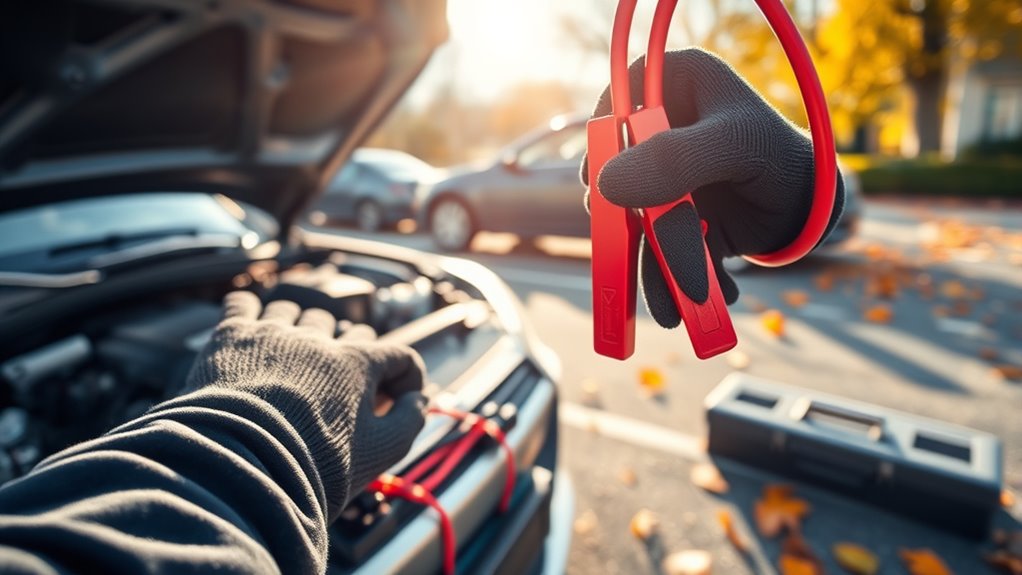To jump-start a car safely, first, gather your jumper cables and verify both vehicles are in park or neutral with the engines off. Locate and identify the positive and negative terminals on both batteries. Connect the red cable to the dead battery’s positive terminal, then the other end to the good battery’s positive. Attach the black cable to the good battery’s negative terminal, and the other end to an unpainted metal surface on the dead car. If you want to learn the full process, keep going!
Key Takeaways
- Ensure both vehicles are parked, turned off, and hoods open before connecting jumper cables.
- Identify and confirm positive (+) and negative (-) battery terminals to avoid mistakes.
- Connect the red cable to the dead battery’s positive terminal and the good battery’s positive terminal.
- Attach the black cable to the good battery’s negative terminal and an unpainted metal surface on the dead car.
- Start the working vehicle first, allow charging, then attempt to start the dead car; disconnect cables in reverse order after it starts.

When your car won’t start because of a dead battery, don’t worry—jump-starting it is a straightforward process that can get you back on the road in no time. First, make sure you have the right tools on hand. An essential part of your emergency kit should include jumper cables. If you don’t have them, it’s wise to invest in a good quality set, as they can be lifesavers in situations like this.
To begin, park the vehicle with the working battery close to your car, ensuring both are in park or neutral. Turn off both vehicles and pop open the hoods. You’ll need to identify the positive and negative terminals on both batteries. The positive terminal is usually marked with a plus sign (+) and often has a red cover. The negative terminal, marked with a minus sign (-), usually has a black cover.
Begin by parking the working vehicle close to yours, ensuring both are in park or neutral, and pop open the hoods.
Next, take the jumper cables. Connect one end of the red cable to the positive terminal of the dead battery. Then, connect the other end of the red cable to the positive terminal of the good battery. After that, attach one end of the black cable to the negative terminal of the good battery. Now comes the critical step—connect the other end of the black cable to an unpainted metal surface on the dead car, away from the battery. This helps prevent sparks that could ignite any gases released by the battery.
Once all the cables are connected, start the vehicle with the working battery. Let it run for a few minutes to charge the dead battery. After that, try starting your car. If it doesn’t start right away, don’t panic. Just give it a few more minutes and then try again. If it starts, great! You’ve successfully jump-started your car. Remember to always keep jumper cables handy in your emergency kit to be prepared for unexpected situations.
Frequently Asked Questions
Can I Jump-Start a Car in the Rain?
Yes, you can jump-start a car in the rain, but you need to take precautions. Wet weather increases the risk of slipping and electrical issues, so make sure you’ve got a secure grip on the cables and avoid standing in puddles. It’s smart to be prepared for emergencies, so keep a set of jumper cables in your trunk. Always prioritize safety by ensuring both cars are parked on stable ground and away from water.
What Should I Do if Sparks Occur During Jump-Starting?
If sparks occur during jump-starting, you should immediately disconnect the cables, keeping them away from each other. Make certain you’re following safety precautions, like wearing gloves and eye protection. Check the connections for any issues, like corrosion or loose clamps. If the sparks persist, it’s best to consult a professional for troubleshooting sparks. Safety’s your priority, so don’t hesitate to seek help if you’re unsure about the situation.
Is It Safe to Jump-Start a Hybrid Vehicle?
Yes, it’s generally safe to jump-start a hybrid vehicle, but you should always prioritize hybrid safety. These cars have battery complexity that can differ from traditional vehicles, so it’s essential to consult your owner’s manual for specific instructions. Make sure you’re using the correct jumper cables and follow the proper sequence to avoid any issues. If you’re unsure, consider calling a professional to help you avoid potential damage to the hybrid system.
How Can I Tell if My Battery Is Completely Dead?
You can tell if your battery’s completely dead by checking the battery indicators on your dashboard; if they’re unresponsive or showing warning lights, that’s a bad sign. Try turning on your headlights or interior lights; if they’re dim or won’t turn on, your battery’s likely dead. For a more accurate assessment, you can perform a voltage testing with a multimeter; anything below 12.4 volts typically indicates a dead battery.
Can Using the Wrong Cables Damage My Car?
Using the wrong cables can feel like inviting a storm into your engine. If you mix up cables, you risk damaging your car’s electrical system. Battery safety is vital; incompatible cables can create sparks or short circuits. Always check for cable compatibility before you connect, ensuring a smooth jump-start. Think of your car as a finely tuned instrument—using the wrong tools can throw everything out of tune. Stay safe and keep your ride humming!
Conclusion
Jump-starting a car doesn’t have to be intimidating. By following these steps, you can safely revive a dead battery and get back on the road. Did you know that nearly 70 million cars on the road today have batteries that are over three years old? This highlights the importance of knowing how to jump-start a car—it’s a handy skill that can save you from being stranded. So, keep this guide handy and drive with confidence!










